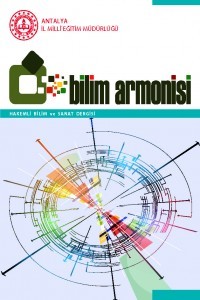Özel Yetenekli Öğrenciler İçin Farklılaştırılmış Matematik Programı Etkinlik Örneği
Matematik Öğretimi, Özel Yetenekli Öğrenci, Farklılaştırma
An Activity Sample of Differentiated Maths Programme for the Gifted Students
Mathematic education, gifted student, scientific creativeness,
___
- Anderson, L. W., Krathwohl, D. R. (2010). Bloom’un Eğitim Hedefleri İle İ̇lgili Sınıflamasının Güncelleştirilmiş Biçimi. (Çev. D. A. Özçelik): Pegem Akademi. Ankara.
- Davis, G. A., Rimm, S. B., Siegle, D. (2013). Education of the gifted and talented (6th ed.): Pearson Education Limited. England.
- Ervynck, G. (2002). Mathematical Creativity. In. D. Tall: Advanced Mathematical Thinking (Ed.) NY: Kluwer Academic Publishers. New York, 42-52.
- Gavin, M. K., Casa, T., Adelson, J. L., Carroll, S. R., Sheffield, L. J. (2009). “The İmpact Of Advanced Curriculum On The Achievement Of Mathematically Promising Elementary Students”. Gifted Child Quarterly, (53):188-202.
- Hatfield, L. L. (2000). “Perspectives On The Field Of Mathematics Education: Toward Global Develop-Ment And Reconstruction”. Proceedings of the Korean School Mathematics Society,( 3):1-8.
- İnan, E. (2018). Teaching Maths to The Gifted Students Through Differentiated Teaching Method. International Conference on Mathematics and Mathematics Education.
- Johnson, D. T.(2000). “Mathematics Curriculum For The Gifted: Comprehensive Curriculum For Gifted Learners” (2nd ed.), (Ed. by J. VanTassel-Baska Allyn and Bacon). 234-255.
- Maker, C. J., Schiever, S. W.(2005). Teaching Models İn Education Of The Gifted (3rd ed.): TX: Pro-ed Inc. Texas.
- Maker, C. J.(1982), Curriculum Development For The Gifted: MD: Aspen Systems Corporation, Rockville.
- Özyaprak, M. (2016). “Üstün Zekâlı ve Yetenekli Öğrenciler İçin Matematik Müfredatının Farklılaştırılması”. Hasan Ali Yücel Eğitim Fakültesi Dergisi, 13(2) :115-128.
- Sak, U. (2011). “Selective Problem Solving (Sps): A Model For Teaching Treative Problem Solving”. Gifted Education International, (27): 349-357.
- Sheffield, L. J.(2003). Extending The Challenge İn Mathematics: Developing Mathematical Promise İn K-8 Pupils: Corwin Pres. Thousand Oaks.
- Sriraman, B. (2004). “The Characteristics Of Mathematical Creativity”. The Mathematics Educator, 14(1):19–34.
- Tanner, D., Tanner, L. M.(1980). Curriculum Development: Theory İnto Practice (2nd ed.): Macmillan, New York .
- Tomlinson, C. A. (2001).How To Differentiate İnstruction İn Mixed-Ability Classrooms. VA: Association for Supervision and Curriculum Development. Alexandria.
- Tomlinson, C. A., Kaplan, S. N., Renzulli, J. S., Purcell, J., Leppien, J., Burns, D.(2002). The parallel curriculum: A Design To Develop High Potential And Challenge High-Ability Learners. CA: Corwin Press, Thousand Oaks.
- Tortop, H. S. (2013). “Üstün Yetenekliler Eğitiminde Farklılaştırma, Modeller, Sorunlar ve Öneriler”. Öğretmen Dünyası Dergisi, (440).
- Van Tassel-Baska, J., Little, C. A.,(2003). ContentBased Curriculum For High- Ability Learners: TX:Prufrock Press, Waco 2003.
- Van Tassel-Baska, J., Stambaugh, T.(2006). Comprehensive Curriculum for Gifted Learners. (3rded.): Pearson Education Inc, Boston 2006.
- VanTassel-Baska, J., Brown, E. F. (2007). “Towards Best Practice: An Analysis Of The Efficacy Of Curriculum Models İn Gifted Education”. Gifted Child Quarterly, (51):342-358.
- ISSN: 2602-4403
- Yayın Aralığı: Yılda 2 Sayı
- Başlangıç: 2018
- Yayıncı: Antalya İl Milli Eğitim Müdürlüğü
Benzer Dizilerin Benzer Özellikleri
Firdevs Nur ALGÜL, Sibel SELÇUK
Mobil Argümantasyon ile Özel Yetenekli Bireylere Adli Bilimler Öğretimi
Ümmüye Nur TÜZÜN, Mustafa TÜYSÜZ
Dede Korkut Hikâyelerinde Kadın ve Aileye Verilen Önemin İncelenmesi
Özel Yetenekli Lise Öğrencilerinde Bilgiye Ulaşmada İnternet Kullanım Düzeylerinin İncelenmesi
Özel Yetenekli Öğrenciler İçin Farklılaştırılmış Matematik Programı Etkinlik Örneği
